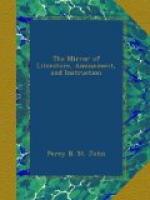[1] Chamber’s Life of Sir Walter Scott.
[2] General Preface to the Waverley Novels, 41 vols.
The house in which Sir Walter Scott was born no longer exists. It was situated at the head of the College Wynd, at its entrance into North College-street. It was thus described by Sir Walter in 1825:—“It consisted of two flats above Mr. Keith’s, and belonged to my father, Mr. Walter Scott, Writer to the Signet. There I had the chance to be born, 15th of August, 1771. My father, soon after my birth, removed to George’s Square, and let the house in the College Wynd, first to Mr. Dundas, of Philipstoun, and afterwards to Mr. William Keith, father of Sir Alexander Keith. It was purchased by the public, together with Mr. Keith’s (the inferior floors), and pulled down to make way for the new College.”
CHILDHOOD.
Mr. Cunningham relates some interesting particulars of this period. Before Sir Walter was two years old, his nurse let him fall out of her arms, so as to injure his right foot, and render him lame for life: “This accident did not otherwise affect his health; he was, as I have been informed by a lady who chanced to live near him, a remarkably active and dauntless boy, full of all manner of fun, and ready for all manner of mischief. He calls himself, in one of his introductions to Marmion—
A self-willed imp; a grondame’s child;
and I have heard it averred, that the circumstance of his lame foot prompted him to take the lead among all the stirring boys in the street where he lived, or the school which he attended: he desired, perhaps, to show them, that there was a spirit which could triumph over all impediments."[3] If this statement be correct, it is a somewhat remarkable coincidence with the circumstance of Lord Byron’s lameness; though, happily, the influence of the accident on the temperament of Scott is not traceable beyond his early years.
[3] Life of Sir Walter Scott; in the Athenaeum, No. 258.
Sir Walter was subsequently removed from Edinburgh, for the improvement of his health, to the farm-house of Sandyknowe, then inhabited by his paternal grandfather, and situated in the loveliest part of the Vale of Tweed. In the neighbourhood, upon a considerable eminence, stands Smailholm Tower, a Border fort which the future poet enshrined in his admirable ballad, The Eve of St. John. The romantic influence of the scenery of the whole district is told with much vigour and sweetness in the introduction to the third canto of Marmion.




